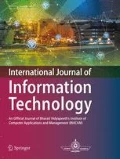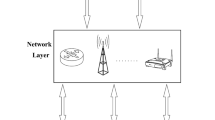Abstract
The Internet plays a vital role in the massive growth of the emerging Internet of Things (IoT). IoT helps all electronic devices to communicate with other devices and with the human with the help of the Internet. IoT enables the devices to sense environmental changes or mission-critical data. These critical data that are sensed by the IoT devices are forwarded to the public cloud storage with the help of Gateway nodes. Later these sensed data are utilized for decision making. However, high-risk insecurity is a major concern in IoT sensed data. In this paper, a trust-based security method with Direct and Indirect trust evaluation technique has been implemented to provide highly secure data transmission in the network. The simulation result has proven that trust-based security can improve data confidentiality when compared with available protocols.







Similar content being viewed by others
References
Amin R, Kumar N, Biswas GP, Iqbal R, Chang V (2018) A light weight authentication protocol for IoT-enabled devices in distributed Cloud Computing environment. Fut Gener Comput Syst 78:1005–1019
Barnes C, Verdier F, Pegatoquet A, Gaffe D, Cottin J (2016) Wireless sensor network protocol property validation through the system's simulation in a dedicated framework. In: 10th International Conference On Signal Processing and Communication Systems (ICSPCS), 2016.
Chiang M, Zhang T (2016) Fog and IoT: an overview of research opportunities. IEEE Internet Things J 3(6):854–864. https://doi.org/10.1109/JIOT.2016.2584538
Choi S, Yang C, Kwak J (2018) System hardening and security monitoring for IoT devices to mitigate IoT security vulnerabili ties and threats. 12(2): 906–918
Comput JPD, Tao M, Ota K, Dong M, Qian Z (2018) AccessAuth: capacity-aware security access authentication in federated-IoT-enabled V2G networks. J Parallel Distrib Comput 118:107–117
Davide M, Celesti A, Maria F, Villari M (2015) Human-computer interface based on IoT embedded systems for users with disabilities, internet of things. User-centric IoT. Springerlinks
Elhoseny M, Ramírez-González G, Abu-Elnasr OM, Shawkat SA, Arunkumar N, Farouk A (2018) Secure medical data transmission model for IoT-based healthcare systems. IEEE Access. https://doi.org/10.1109/ACCESS.2018.2817615
Feng W, Qin Y, Zhao S, Feng D (2018) AAoT: lightweight attestation and authentication of low-resource things in IoT and CPS. Comput Netw 134:167–182
Gedawy H, Sannan T, Abderrahmen M, Khaled H (2016) Cumulus: a distributed and flexible computing testbed for edge cloud computational offloading. In: Cloudification of the internet of things (CIoT), IEEE, pp 1–6.
Girao J, Westhoff D, Mykletun E, Araki T (2007) TinyPEDS tiny persistent encrypted data storage in asynchronous wireless sensor networks. Ad Hoc Netw 5(7):1073–1089
Gupta AK, Johari R (2019) IOT based electrical device surveillance and control system. In: 2019 4th International Conference on Internet of Things: Smart Innovation and Usages (IoT-SIU), Ghaziabad, India, pp. 1–5, https://doi.org/10.1109/IoT-SIU.2019.8777342
Jian S, Anxi W, et al. (2017) An efficient centroid-based routing protocol for energy management in WSN-Assisted IoT. IEEE Access 5
Lalitha T, Umarani R (2012) Energy efficient cluster based key management technique for wireless sensor network. Int J Adv Eng Technol 3(2):186–190
Li T, Chen W, Tang Y, Yan H (2018) A homomorphic network coding signature scheme for multiple sources and its application in IoTs.
Mangia M, Pareschi F, Rovatti R, Setti G (2018) Low-cost security of IoT sensor nodes with rakeness-based compressed sensing: statistical and known-plaintext attacks. IEEE Trans Inf Foren Secur 13(2):327–340. https://doi.org/10.1109/TIFS.2017.2749982
Anne HN Mario G, et al. (2017) IoT middleware: a survey on issues and enabling technologies. IEEE Internet Things J 4(1)
Nikravan M, Movaghar A, Hosseinzadeh M (2018) A lightweight defense approach to mitigate version number and rank attacks in low-power and lossy networks. Wirel Pers Commun 99(2):1035–1059
Patterson RE (2017) Intuitive cognition and models of human–automation interaction, human factors: the journal of the human factors and ergonomics society. Sage J 59(1)
Puthal et al. (2015) A dynamic key length based approach for realtime security verification of big sensing data stream. In: Proc. web information systems engineering (Wise), pp. 93–108
Rahmani Hosseinabadi AA, Vahidi J, Saemi B et al (2019) Extended genetic algorithm for solving open-shop scheduling problem. Soft Comput 23:5099–5116. https://doi.org/10.1007/s00500-018-3177-y
Renjith PN (2020) Towards secure data forwarding with anfis and trust evaluation in wireless sensor networks. Wirel Person Commun. https://doi.org/10.1007/s11277-020-07392-1
Roy SS, Puthal D, Sharma S, Mohanty SP, Zomaya AY (2018) Building a sustainable internet of things: energy-efficient routing using low-power sensors will meet the need. IEEE Consu Electron Mag 7(2):42–49
Ruan O, Zhang Y, Zhang M, Zhou J, Harn L (2018) After-the-fact leakage-resilient identity-based. 12(2): 2017–2026
Samaila MG, Sequeiros JBF, Simões T, Freire MM, Inácio PRM (2020) IoT-HarPSecA: A framework and roadmap for secure design and development of devices and applications in the IoT space. IEEE Access 8:16462–16494. https://doi.org/10.1109/ACCESS.2020.2965925
Sha K, Wei W, Andrew Yang T, Wang Z, Shi W (2018) On security challenges and open issues in internet of things. Fut Gener Comput Syst 83:326–337
Shin S, Kwon T (2018) Two-factor authenticated key agreement supporting unlinkability in 5G-integrated wireless sensor networks. IEEE Access 6:11229–11241
Tewari A, Gupta BB (2018) Security, privacy and trust of different layers in internet-of-things (IoTs) framework. Fut Gener Comput Syst
Xiao W, Li Y, Ke C (2005) SLEACH secure low energy adaptive clustering hierarchy protocol for wireless sensor networks. Wuhan Univ J Natl Sci 10(1): 127–131
Zhou Q, Yang G, He L (2014) A secure enhanced data aggregation based on ECC in wireless sensor network. Sens J 14(4):6701–6721
Author information
Authors and Affiliations
Corresponding author
Rights and permissions
About this article
Cite this article
Renjith, P.N., Ramesh, K. & Sasikumar, S. An improved trust-based security framework for internet of things. Int. j. inf. tecnol. 13, 677–685 (2021). https://doi.org/10.1007/s41870-020-00574-x
Received:
Accepted:
Published:
Issue Date:
DOI: https://doi.org/10.1007/s41870-020-00574-x




